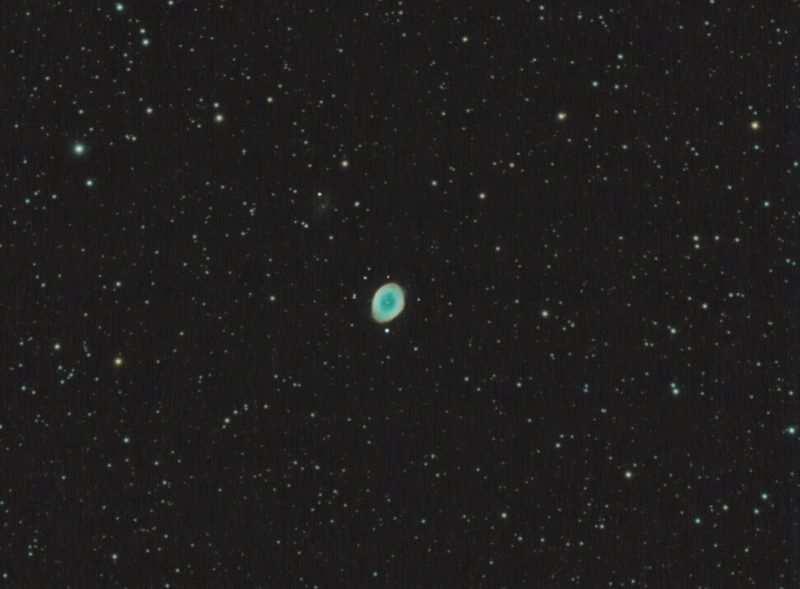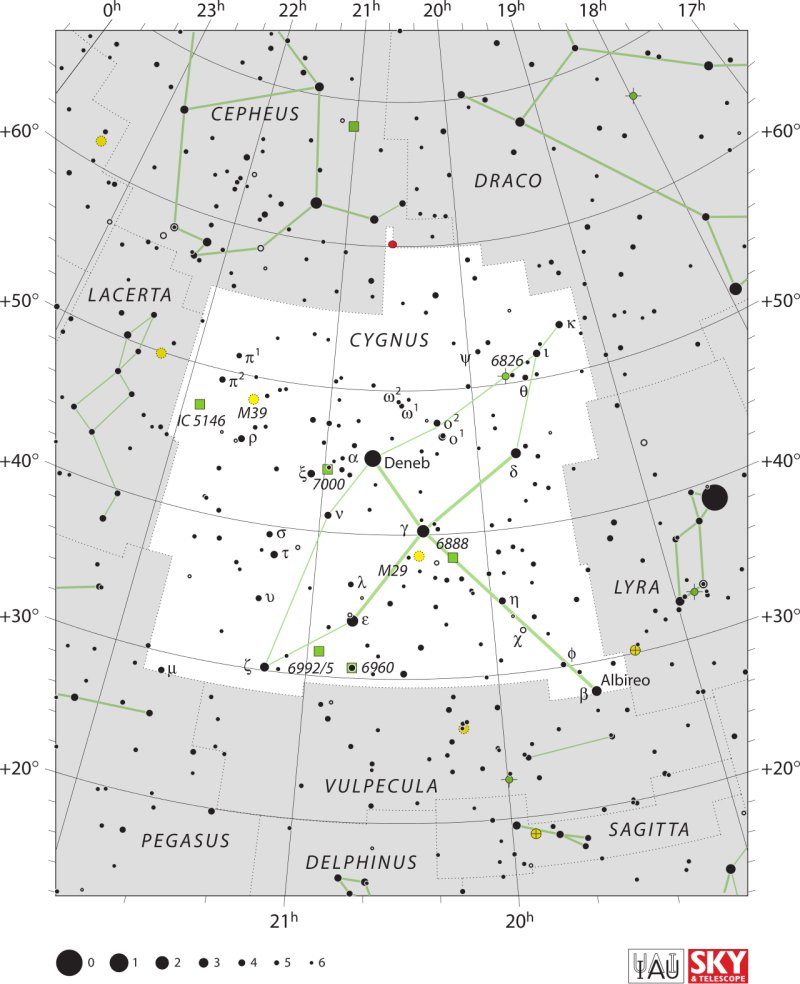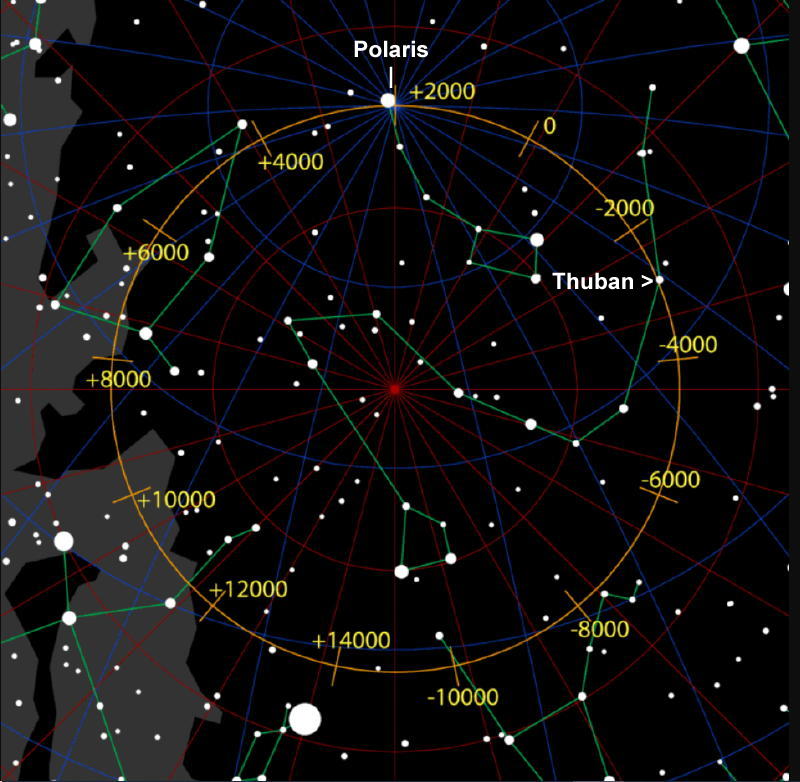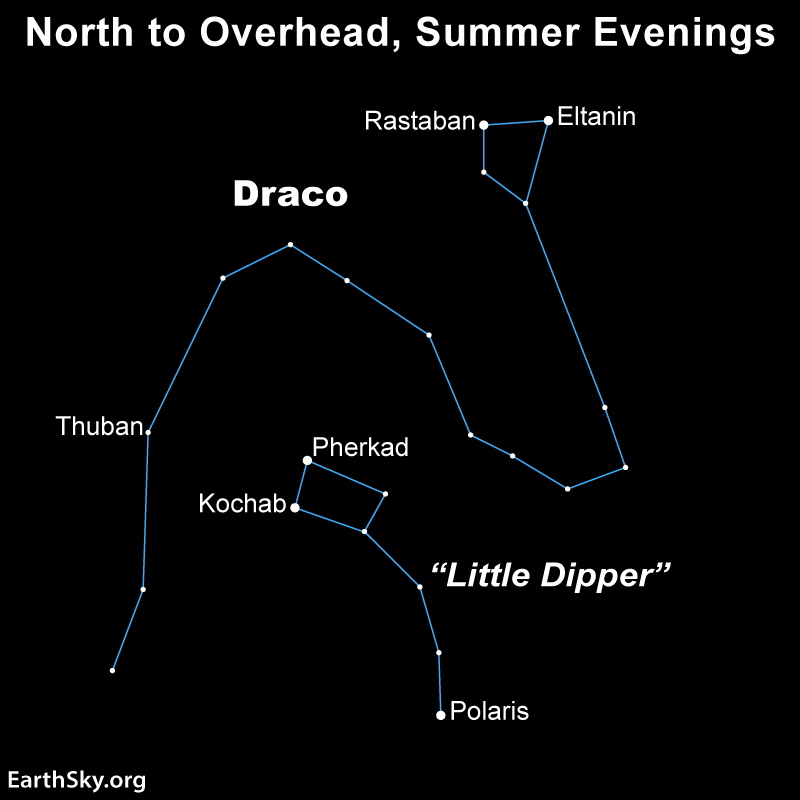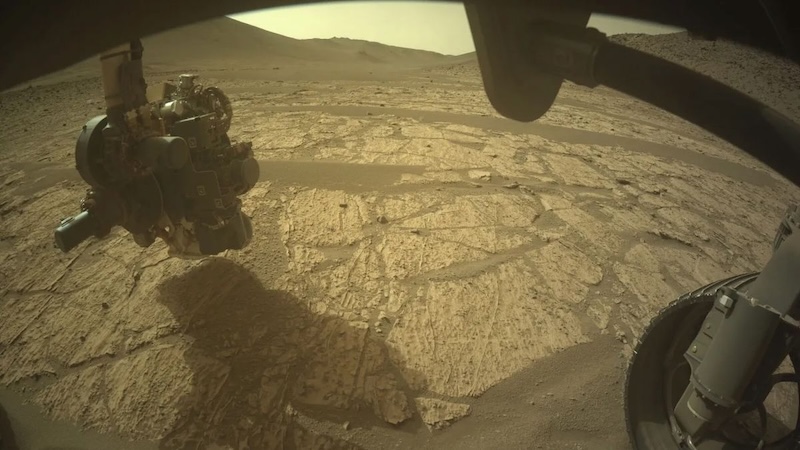
- NASA’s Perseverance rover reached rock outcrops called Bright Angel, in an ancient river channel known as Neretva Vallis.
- The outcrops may be either ancient rock exposed by river erosion or sediments that filled the channel.
- Bright Angel is the latest science target in Neretva Vallis. The rover also investigated an unusual rock called Atoko Point.
Perseverance rover explores an ancient riverbed
NASA’s Perseverance rover has been busy investigating an ancient river channel on Mars called Neretva Vallis. It lies alongside the inner wall of Jezero crater. The channel, with sand dunes, boulders and rocky outcrops, is chock full of geologically exciting features. On June 13, 2024, NASA said the rover reached its latest target, Bright Angel. The light-toned rocky outcrops in Bright Angel are distinct among the surrounding darker rocks and sand dunes. The mission team said the outcrops are likely either rock exposed by past river erosion or sediments that once filled the channel.
Along the way, the rover also saw an intriguing white speckled boulder called Atoko Point. It contains pyroxene and feldspar minerals and may have formed in ancient hot magma.
Perseverance rover reaches Bright Angel
In order to reach Bright Angel, Perseverance had to cross the floor of the river channel. Bright Angel appears as a lighter patch inside the channel. The rover reached Bright Angel on June 9, after meandering around some sand dunes and avoiding larger boulders.
This route was shorter than the one the mission team was originally going to take. Overall, it cut the drive time down by several weeks.
Bright Angel is just the latest stop in the Perseverance rover’s 4th science campaign. Perseverance is looking for carbonate and olivine deposits within the Margin Unit, which Bright Angel is part of.
A route change on my way to Bright Angel has led me through an unexpectedly diverse geological playground, Neretva Vallis! This ancient river channel – which carried most of the water that flowed into Jezero Crater billions of years ago – is filled with intriguing boulders. pic.twitter.com/4faWzFZJpt
— NASA's Perseverance Mars Rover (@NASAPersevere) June 13, 2024
Having scooted across Neretva Vallis, @NASAPersevere is now studying an area of light-toned rocks called "Bright Angel". Here's a close-up of the rocks… Geologists, feel free to tell us what you think we're seeing here… Image Credit: NASA/JPL-Caltech/ASU/S Atkinson pic.twitter.com/gIRTl8m8de
— Stuart Atkinson (@mars_stu) June 23, 2024
Navigating rough terrain
Perseverance first drove along a ridge alongside the channel. It wasn’t always an easy trip, however. Evan Graser, Perseverance’s deputy strategic route planner lead at NASA’s Jet Propulsion Laboratory in Southern California, said:
We started paralleling the channel in late January and were making pretty good progress, but then the boulders became bigger and more numerous. What had been drives averaging over a hundred meters per Martian day went down to only tens of meters. It was frustrating.
Perseverance has technological tools to help it navigate rough terrain. It can use its cameras to plan drives of up to 100 feet (30 meters) at a time. But to go farther, it uses its auto-navigation system called AutoNav. In this case, however, the boulders began to become more numerous than anticipated. AutoNav detected them but would make the rover stop as a precaution. That slowed down the rover’s travel’s considerably.
Crossing the river channel
Consequently, the mission team decided to cut across the river channel instead. They had to navigate a 1,300-foot (400-meter) dune field, but that was easier than avoiding the boulders. Graser said:
We had been eyeing the river channel just to the north as we went, hoping to find a section where the dunes were small and far enough apart for a rover to pass between, because dunes have been known to eat Mars rovers. Perseverance also needed an entrance ramp we could safely travel down. When the imagery showed both, we made a beeline for it.


Atoko Point: Perseverance rover finds unusual white boulder
One of the most interesting discoveries that Perseverance made while journeying to Bright Angel was an interesting white boulder that stood out from all the others around it. It was on a small hill called Mount Washburn, which is covered in rocks and boulders. The mission team nicknamed it Atoko Point. The light-colored speckled rock looked distinctly different from the other reddish rocks. What was it? Brad Garczynski at Western Washington University in Bellingham said:
The diversity of textures and compositions at Mount Washburn was an exciting discovery for the team, as these rocks represent a grab bag of geologic gifts brought down from the crater rim and potentially beyond. But among all these different rocks, there was one that really caught our attention.
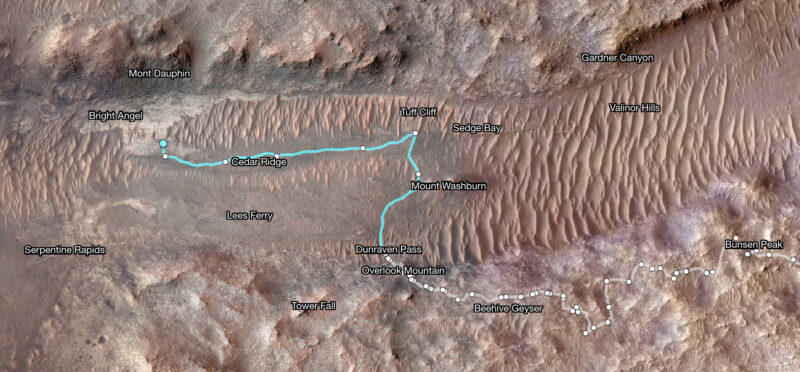
Ancient subsurface magma?
Atoko Point is 18 inches (45 cm) wide and 14 inches (35 cm) tall. It kind of looked like granite, but what was it actually made of? Analysis by Perseverance showed it is composed of the minerals pyroxene and feldspar. It’s also unique regarding its size, shape and arrangement of the mineral grains and crystals in it, and maybe even its chemical composition. It’s the first of its kind the rover has seen on Mars.
It may have formed in a subsurface body of hot magma in Jezero crater. Or it could have formed elsewhere, and then one of the ancient rivers of the region transported it to its current location.
After finishing at Mount Washburn, Perseverance traveled 433 feet (132 m) to Tuff Cliff. After that, it made the final leg of the journey to Bright Angel, covering 1,985 feet (605 m).
Bottom line: NASA’s Perseverance rover on Mars has reached an area of flat light-toned rocky outcrops called Bright Angel. The intriguing rocks are in an ancient river channel.
Read more: Perseverance rover reveals history of ancient habitable lake
Read more: 10 months of Perseverance: New Mars discoveries
The post Perseverance rover explores Bright Angel in ancient riverbed first appeared on EarthSky.
from EarthSky https://ift.tt/vwZUj3L

- NASA’s Perseverance rover reached rock outcrops called Bright Angel, in an ancient river channel known as Neretva Vallis.
- The outcrops may be either ancient rock exposed by river erosion or sediments that filled the channel.
- Bright Angel is the latest science target in Neretva Vallis. The rover also investigated an unusual rock called Atoko Point.
Perseverance rover explores an ancient riverbed
NASA’s Perseverance rover has been busy investigating an ancient river channel on Mars called Neretva Vallis. It lies alongside the inner wall of Jezero crater. The channel, with sand dunes, boulders and rocky outcrops, is chock full of geologically exciting features. On June 13, 2024, NASA said the rover reached its latest target, Bright Angel. The light-toned rocky outcrops in Bright Angel are distinct among the surrounding darker rocks and sand dunes. The mission team said the outcrops are likely either rock exposed by past river erosion or sediments that once filled the channel.
Along the way, the rover also saw an intriguing white speckled boulder called Atoko Point. It contains pyroxene and feldspar minerals and may have formed in ancient hot magma.
Perseverance rover reaches Bright Angel
In order to reach Bright Angel, Perseverance had to cross the floor of the river channel. Bright Angel appears as a lighter patch inside the channel. The rover reached Bright Angel on June 9, after meandering around some sand dunes and avoiding larger boulders.
This route was shorter than the one the mission team was originally going to take. Overall, it cut the drive time down by several weeks.
Bright Angel is just the latest stop in the Perseverance rover’s 4th science campaign. Perseverance is looking for carbonate and olivine deposits within the Margin Unit, which Bright Angel is part of.
A route change on my way to Bright Angel has led me through an unexpectedly diverse geological playground, Neretva Vallis! This ancient river channel – which carried most of the water that flowed into Jezero Crater billions of years ago – is filled with intriguing boulders. pic.twitter.com/4faWzFZJpt
— NASA's Perseverance Mars Rover (@NASAPersevere) June 13, 2024
Having scooted across Neretva Vallis, @NASAPersevere is now studying an area of light-toned rocks called "Bright Angel". Here's a close-up of the rocks… Geologists, feel free to tell us what you think we're seeing here… Image Credit: NASA/JPL-Caltech/ASU/S Atkinson pic.twitter.com/gIRTl8m8de
— Stuart Atkinson (@mars_stu) June 23, 2024
Navigating rough terrain
Perseverance first drove along a ridge alongside the channel. It wasn’t always an easy trip, however. Evan Graser, Perseverance’s deputy strategic route planner lead at NASA’s Jet Propulsion Laboratory in Southern California, said:
We started paralleling the channel in late January and were making pretty good progress, but then the boulders became bigger and more numerous. What had been drives averaging over a hundred meters per Martian day went down to only tens of meters. It was frustrating.
Perseverance has technological tools to help it navigate rough terrain. It can use its cameras to plan drives of up to 100 feet (30 meters) at a time. But to go farther, it uses its auto-navigation system called AutoNav. In this case, however, the boulders began to become more numerous than anticipated. AutoNav detected them but would make the rover stop as a precaution. That slowed down the rover’s travel’s considerably.
Crossing the river channel
Consequently, the mission team decided to cut across the river channel instead. They had to navigate a 1,300-foot (400-meter) dune field, but that was easier than avoiding the boulders. Graser said:
We had been eyeing the river channel just to the north as we went, hoping to find a section where the dunes were small and far enough apart for a rover to pass between, because dunes have been known to eat Mars rovers. Perseverance also needed an entrance ramp we could safely travel down. When the imagery showed both, we made a beeline for it.


Atoko Point: Perseverance rover finds unusual white boulder
One of the most interesting discoveries that Perseverance made while journeying to Bright Angel was an interesting white boulder that stood out from all the others around it. It was on a small hill called Mount Washburn, which is covered in rocks and boulders. The mission team nicknamed it Atoko Point. The light-colored speckled rock looked distinctly different from the other reddish rocks. What was it? Brad Garczynski at Western Washington University in Bellingham said:
The diversity of textures and compositions at Mount Washburn was an exciting discovery for the team, as these rocks represent a grab bag of geologic gifts brought down from the crater rim and potentially beyond. But among all these different rocks, there was one that really caught our attention.

Ancient subsurface magma?
Atoko Point is 18 inches (45 cm) wide and 14 inches (35 cm) tall. It kind of looked like granite, but what was it actually made of? Analysis by Perseverance showed it is composed of the minerals pyroxene and feldspar. It’s also unique regarding its size, shape and arrangement of the mineral grains and crystals in it, and maybe even its chemical composition. It’s the first of its kind the rover has seen on Mars.
It may have formed in a subsurface body of hot magma in Jezero crater. Or it could have formed elsewhere, and then one of the ancient rivers of the region transported it to its current location.
After finishing at Mount Washburn, Perseverance traveled 433 feet (132 m) to Tuff Cliff. After that, it made the final leg of the journey to Bright Angel, covering 1,985 feet (605 m).
Bottom line: NASA’s Perseverance rover on Mars has reached an area of flat light-toned rocky outcrops called Bright Angel. The intriguing rocks are in an ancient river channel.
Read more: Perseverance rover reveals history of ancient habitable lake
Read more: 10 months of Perseverance: New Mars discoveries
The post Perseverance rover explores Bright Angel in ancient riverbed first appeared on EarthSky.
from EarthSky https://ift.tt/vwZUj3L










